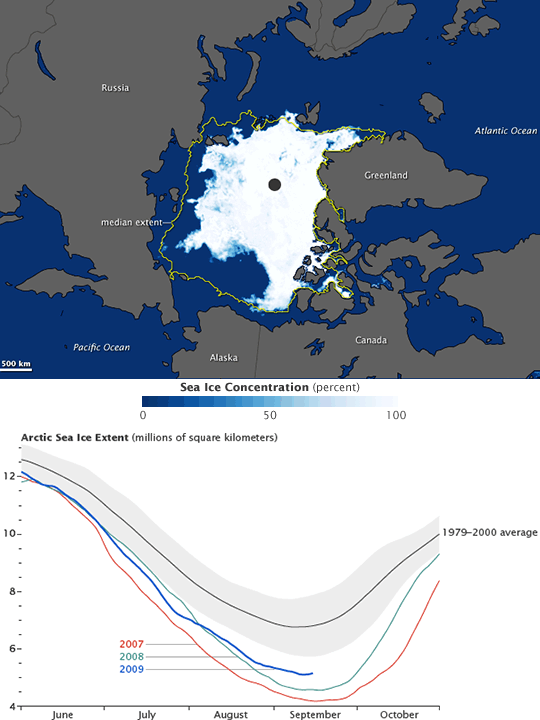Over the last thirty years the Arctic ice has been shrinking almost continuously. Since the beginning of the satellite recordings in 1979 the area of the perennial ice has been steadily decreasing at a rate of about 10% per decade. The previous record low was that of September 2005, when the ice coverage fell for the first time below 5.5 million square kilometers. In September 2007 however the sea ice extent dropped to a historical minimum of 4.3 square kilometers, 38% below the average of the last thirty years, and a whopping 24% less than the previous record low of 2005. The northernmost edge of the ice was at 85.5 degrees north, no more than 500 km from the geographical pole.
Of course, a one year drop in the ice coverage usually does not mean much. There is quite some fluctuation in the annual ice coverage, as illustrated by the annual minimum of 1996, which actually was the highest of the previous 13 years. But the record low of 2007 was so far below average that it is really starting to concern scientists. The trend in decreasing ice cover seems to be getting stronger and stronger as time goes on.
Polar bears are denied their historic length of seal hunting season due to late formation and early thaw of pack ice

The accelerating decline in sea ice may be due to changes in climate brought on by the lack of sea ice itself. This has to do with the much lower albedo of ocean water compared to that of ice: the paler the object, the more it reflects the energy of the sun. Since ocean water is much darker than ice, it absorbs more energy, and consequently adds to the warming of the planet. This is a positive feedback system: the more the ice melts, the warmer the polar region gets. And the longer this process continues, the harder it will become for the ice to recover in winter.

Evolution of Arctic sea ice extent in August since the beginning of the satellite measurements in 1979. Even though the actual minima of both 2005 and 2007 occurred in September (instead of August), this chart clearly shows the drastic decrease in arctic sea ice over the last 30 years. - Source: Climate Progress
The sea ice decline is a vast problem on its own since it contributes to global warming, but it also lies at the basis of many other problems: it contributes to rising sea levels and threatens the survival of polar bears.
Indirectly the warming of the arctic region leads to the loss of permafrost which in turn triggers arctic methane release – methane is a greenhouse gas 20 times stronger than carbon dioxide – and might affect ocean circulation, in the worst case shutting down the ocean conveyor belt that allows the Gulf Stream to bring warmer water to the Atlantic coast of North America and Europe. This might sound contradictory, but the result would be a cooling effect in particular areas like Iceland, Ireland, the Nordic countries, and Britain that are warmed by the North Atlantic drift.
After the record low in 2007, the Arctic ice sheet slowly and almost completely recovered during the following winter, but the newly formed ice was thinner and less dense than the ice that disappeared during the summer of 2007.
Consequently, and because global warming has not diminished, most of this new ice again disappeared during the summer of 2008. The annual minimum was not as low as in the year before, but it nevertheless was second to 2007 for the record-lowest extent of sea ice. Contributing to the near record sea ice minimum in 2008 was a month-long period in the summer that saw the fastest-ever rate of seasonal retreat during that period. From August 1 to August 31, NASA data show that arctic sea ice extent declined at a rate of 32,700 square miles per day, compared to a rate of about 24,400 square miles per day in August 2007.
The past winter of 2008-2009 once again was cold enough to allow most of the area to be covered with ice – almost, since the annual maximum extent of the ice is also declining – but once again this layer of ice was fragile and thin compared to previous years.
This year (2009) the melting season seems to have been less severe than the previous two years. The slower decline is primarily due to a recent atmospheric circulation pattern, which transported ice toward the Siberian coast and discouraged export of ice out of the Arctic Ocean.
According to the National Snow and Ice Data Center, in 2009, the sea ice most likely reached its minimum extent on September 12. Again the minimum was less drastic than the one in 2007 – it was even a bit better than the minimum in 2008 – but it’s still far lower than the mean minimum ice extent between 1979 and 2000, as you can see in the picture below.

Above: Minimum sea ice extent of 2009 as it occurred on September 12th - Source: NASA Earth Observatory
Below: Arctic sea ice extent in the years 2009, 2008 and 2007 compared to the 1979-2000 average
Source : National Snow and Ice Data Center
Sources
Arctic Sea Ice Minimum 2009 - Earth Protect
National Snow and Ice Data Center
Polar Bears Go Hungry as Icy Habitat Melts Away - Inter Press Service
'Remarkable' Drop in Arctic Sea Ice Raises Questions - NASA
Sea Ice in Retreat - New York Times
Wikipedia - Albedo - Arctic shrinkage - Thermohaline circulation - Greenhouse gas
Links
NOAA Animation : Arctic Sea Ice Reaches 3rd Lowest Minimum Extent
Arctic Sea Ice - Earth Observatory World of Change
Extreme Ice Survey
Projected Losses of Arctic Sea-Ice and Polar Bear Habitat may be Reduced if Greenhouse Gas Emissions are Stabilized
This page was written in 2009, as additional information to the poster series "10 years of Imaging the Earth"